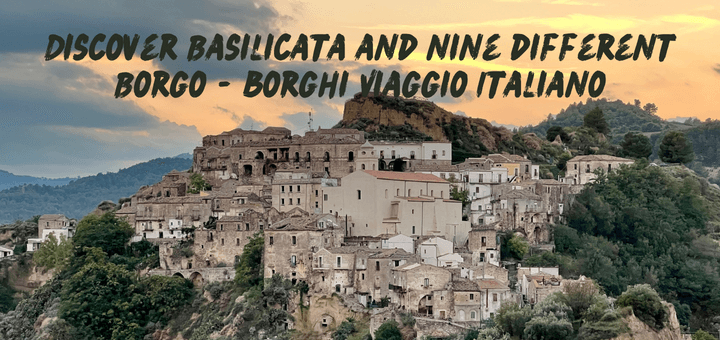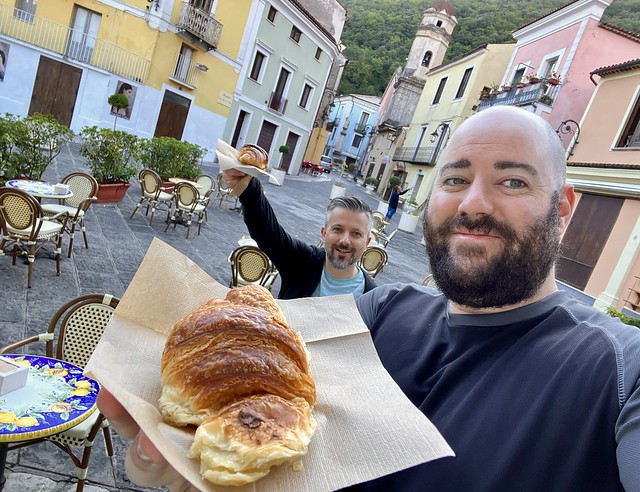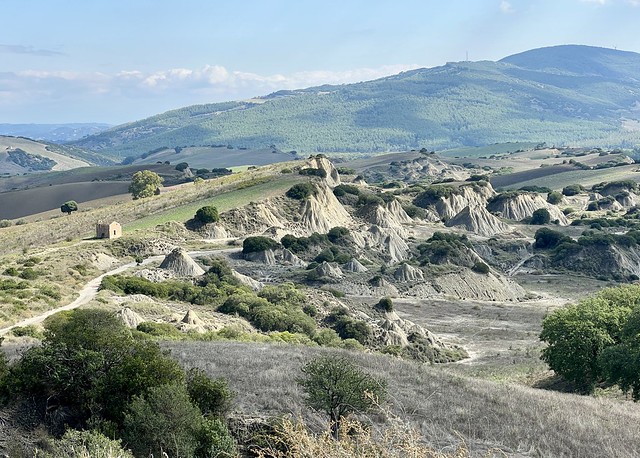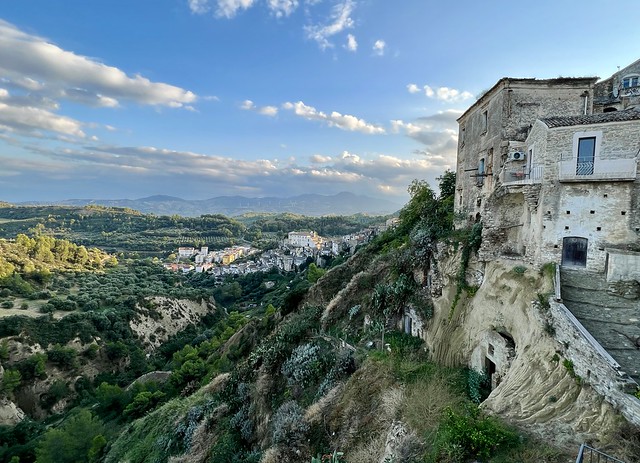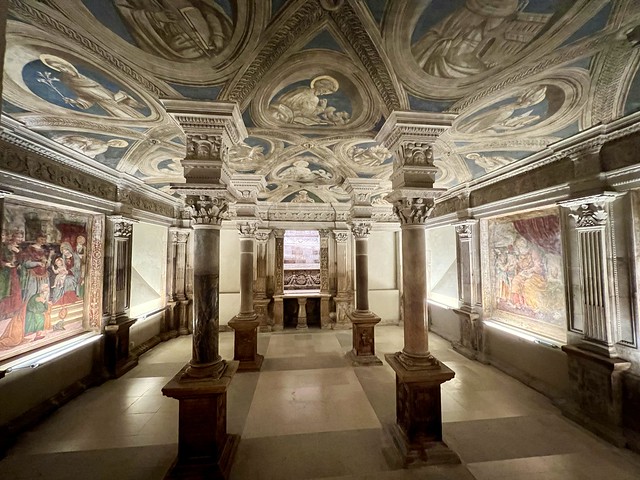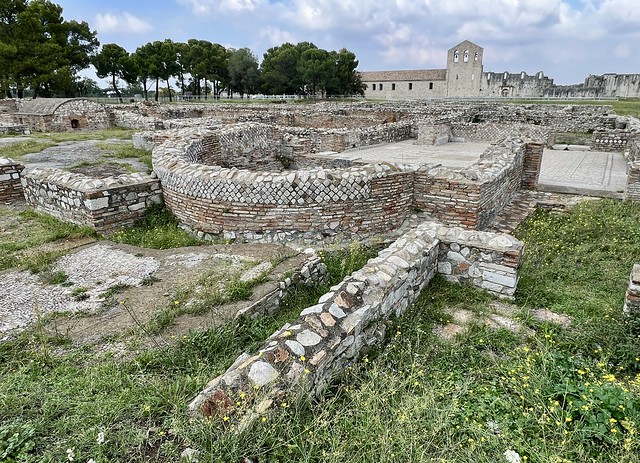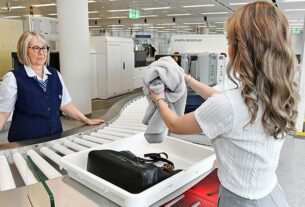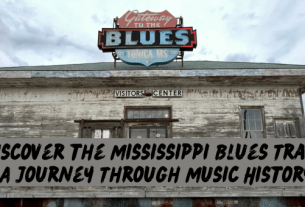|
Getting your Trinity Audio player ready...
|
Did you know that Basilicata is the second least visited region in Italy?
Not only this, but my adventure to Basilicata even avoided the most popular tourist spots in one of the least visited regions of Italy.
The idea of the Viaggio Italiano trip is to discover nine remote villages — known as the Borghi Italiani — across the region of Basilicata across the provinces of Maratea, Venosa and Aliano.
I’ve travelled around Italy multiple times before, but never visited the south.
The difficulty comes with how remote it is, which while something of a challenge usually makes for a more exciting, interesting trip. I’m all for it.
Basilicata is an area of forests and mountains located in the southern part of Italy. It borders the regions of Calabria and Puglia, as well as the Tyrrhenian and Ionian Seas.
Matera is known for its vast hillside of caves and is the most popular area of Basilicata for visitors, home to many of the most visited attractions in the region.
For this reason, we didn’t visit Matera but did drive past our intended route. Instead, we wanted to showcase somewhere less travelled, and focus on the other side of Basilicata.
What is the experience like travelling around Basilicata in the low season?
I wanted to share with you my experience of travelling around Basilicata in the low season and share some travelling tips.
Firstly, a language barrier does exist in Basilicata and is an issue in the region compared to other parts of Italy. Basilicata is not used to having loads of tourists, which isn’t a bad thing. So best to learn some basic Italian before you depart or get ready to whip out Google translate when you need it, which did come in handy.
Public transport is pretty much non-existent in Basilicata. I wouldn’t run the risk of relying on it either, as you could be waiting a long time. If you want to explore the depths of Basilicata, you will need to pick up a rental car.
Make sure you take out all the full insurance coverage policy as well, as you will bump into a lot of potholes along the narrow windy cobbled streets.
Basilicata doesn’t have much of an international airport, your best bet would be to fly into Napoli as your starting hub which has many international connections.
Especially if you want to pick up a rental car. Basilicata is a few hours’ drive away so this works out as your best option.
Regarding food, you will find some of the best Italian cuisines in Basilicata in their most natural and rustic forms.
Basilicata is two steps behind the rest of Italy so you will find very traditional dishes here that come with the most simplistic and beautiful flavours.
It’s taking Italian cooking back to its basics, but with fresh, powerful flavours that will delight your pallet.
For example, the Lucanica di Picerno, which is a type of pork sausage which is loved dearly across all of Italy. Lucanica is a name meaning a local from Basilicata. I’m pretty sure the local name was given first before the sausage.
My favourite dish from Basilicata was a crispy dried sweet peppers dish called pepperoni cruschi, which goes perfectly well sprinkled on top of homemade pasta.
I just hope that you can find an open place to eat, that’s the only issue that I faced.
We were travelling around in October, the low season, and most Borgo would only have one location open if that at all.
Opening time for dinner would be after 20:00, and restaurants are all closed on Sundays or closed on Mondays.
Some restaurants required a reservation as they only make the amount of food exactly for the booking numbers.
Some had no menu at all, or fixed price and you get what was in season at the time.
And vegetarians, I’m sorry, good luck, that’s all I can say, this is the home of Italian sausage and they rarely have a veggie option on the menu. No harm in asking, you might find it a challenge.
My biggest travel tip for Basilicata in the low season would be to stock up when you see a mini market.
Just so you can pick up some supplies to make breakfast, pack lunch and maybe an emergency meal if you get caught short.
It almost happened on a few occasions, and making lunch for myself took a lot of the hassle out of finding a place to eat every day.
What I liked most about many of the deli counters in Basilicata is they will happily put together a sandwich for you if you ask nicely.
It’s always a nice option to cook local food if your guest house has a kitchen you can use anyway.
At this point, I would like to state that all the above made this trip an incredible adventure.
I had no idea that Italy could be a difficult or adventurous country to visit, and I loved Basilicata for that.
It took me back to my earlier days of travelling, when it all used to be a challenge.
The challenges made the trip even more enjoyable. I hadn’t experienced this type of travel in Europe for a long time, and I’m all for it.
Basilicata is an absolutely beautiful area to discover and a majority of the time we had the whole place to ourselves.
Roman ruins would be packed if in Rome. In Basilicata, the ruins are empty and with an entrance fee of only €2.50!
In every Borgo we arrived in, the locals would greet us with curiosity wanting to know our story, and why we were travelling around the remote parts of Basilicata.
A Borgo is a special unique place with beautiful silence (unless Napoli’s football club scores a goal) surrounded usually by nature and scenic views with a real local atmosphere.
What is a Borgo, Borghi Italiani and Viaggio italia?
Great question. When I first heard about a Borgo, I had no idea what it was.
Now, I’m a Borgo expert after visiting nine of them. Let me explain.
You know when you’re driving through the UK and you see those picturesque villages going between towns? They usually have a church, a local community hall, a pub, a post office, and a corner shop, with a selection of cosy cottages with maybe a rugby field or cricket ground chucked in for good measure. Is that a Borgo? kind of.
I did try to search through my own culture to define a Borgo, but it is uniquely Italian in its ways.
Normally located on the side of a hill, a place of worship can be found with a bell tower, cobbled streets, an espresso bar that sells all sorts of things from shots of grappa to lottery tickets, a deli counter that doubles up as a small mini market, old houses that are either lived in and loved or left abandoned for hundreds of years. Loads of parked Fiat Pandas 4X4, Piaggio Ape or Vespa Scooters – the popular Borgo transport of choice.
I hope that paints a picture of a Borgo, sort of like an English village but in its Italian style.
Borghi Italiani is a selection of Borgo in Italy and a Borgo Italiano is one Borgo on its own. Just wanted to clear that all up before we get started. I hope that has painted the picture of a Borgo.
Viaggio Italia translated into English is an Italian Trip.
And if you search using the hashtag: #viaggioitaliano across all the different social media platforms you will find 21 digital content creators travelling across all 21 regions across Italy.
Let’s get the Borgo adventure across Basilicata started!
For this adventure, I teamed up with Scott Tisson from Intrepid Escape so we could turn this journey into a road trip, as driving was an important aspect of discovering the off-the-beaten-path of Basilicata.
Each Borgo along our route across Basilicata had its own unique story to tell and its own identity.
Here is my road trip travel guide to visiting nine Borghi around Basilicata, Italy:
Visiting my first Borgo in Basilicata, Moliterno
The first Borgo Italiano we visited in Basilicata was the village of Moliterno.
Popular for its castle (Castello Medioevale di Moliterno), offering stunning views overlooking the surrounding valleys from the high tower.
We also explored the Faggeto wood oasis, which is a great spot for hiking & biking.
Lastly, we stopped off to try some local cheese, Pecorino di Moliterno which is aged for 12 months to give it a unique strong flavour. This was an incredible (and delicious) experience.
Not bad for our first day exploring our first Borgo in Basilicata.
Onwards to Maratea and it’s stunning coastline
Guest house: Beb il Vicoletto
Our next stop in Basilicata is the coastal Borgo of Maratea.
Popular for its statue of the Christ the Redeemer, sitting on top of the Monte San Biagio offers spectacular sunset views.
You can find a selection of hiking trails that will take you from the main town up to the top of Monte San Biagio. The main road leading up is a popular cycling track too if you have the energy to get to the top.
Also, another popular hiking trail to enjoy in the area is the stunning Tyrrhenian coastal paths that will take you along to some wonderful beach spots too.
The Borgo of Latronico
Guest house: Monteverde
Our next Borgo stop is the town of Latronico.
Before you enter Latronico you will first be greeted by the most popular attraction, the symbol of Latronico, which happens to be situated on a roundabout at the entrance of the Borgo.
Two large white stone hands cupping a water fountain shooting up between the middle of them. It’s a sight that you simply have to see for yourself.
Head to Taverna Nonna Vera for a great place to eat for lunch, serving traditional Basilicata dishes with a modern twist.
Visit the contemporary art gallery called Museo Del Termalismo, as well as the open-air art gallery called Billboards, opera di Maurizio Montagna. It’s an empty billboard frame allowing you to enjoy the backdrop of nature.
Latronico is also home to a spa centre called Terme Lucane. However, the spa is rather dated and lacks facilities and is more catered towards the older generation for medical use.
However, the highlight of the Terme Lucane was a trail that can be found at the back which will take you to a selection of spectacular waterfalls. This a real surprise, as it was hidden away in the corner waiting to be discovered.
Latronico also has a pleasant and somewhat difficult hiking trail if you’re up for the challenge.
From Pollino Park to reach Monte Alpi (Pizzo Falcone) and Monte Santa Croce.
The route starts from Calde and begins to climb along the path crossing the Piana dei Provini. From here begins the steeper climb to reach the peaks.
The hike is a loop of around 14km and can take you around 6 hours to complete.
If you’re looking for a place to eat in the evening, Just Burger & Pizza do an amazing pizza straight from the wood oven and is a great spot to watch the football with the locals.
Next stop, the Borgo of Aliano
Guest house: La Casa dell Americano
The next stop in Basilicata is the Borgho of Aliano which is located in the province of Matera.
Famous for the history of Carlo Levi — a popular activist, author, journalist, painter and doctor who was exiled to Aliano in 1935.
You can find a park and statue dedicated to him in Aliano as well as a museum and art gallery showcasing his works.
Aliano also has a wonderful selection of street art as well as stunning views overlooking the unique landscape of the Calanchi.
For an incredible dining experience in Aliano, head to Taverna La Contadina sisina. Don’t ask for a menu, you won’t find one here. Simply turn up, pay a set fee of around €25 and a selection of 16 courses will start showing up one by one. All meals served are locally produced in Basilicata and seasonal, they base the menu on what’s on offer on the day. Table wine is included. It sure is a feast and a great way to sample classic Basilicata dishes with a touch of local hospitality.
Driving through the incredible landscape of the Calanchi
Driving from Aliano to Tursi. Take the option for the more scenic route through the Calanchi.
The Calanchi is also known as the Badlands as it has a unique moonscape-like landscape.
Because the area’s soil is mainly made up of clay, this is what has formed over thousands of years to create this strange landscape that you see.
You simply have to see it for yourself, or you wouldn’t believe it exists.
A special place for sure and one experience that is unique to Basilicata for those on a road trip, so make sure you don’t miss the turning for this alternative route through the Calanchi.
Moving on to Tursi and the Borgo of Rabatana
Guest house: The Mandarine, Orangery Retreat
The Borgo of Rabatana is located above the town of Tursi and has a deep history said to date back to the year 800.
Rabatana was built by the Saracens who lived in the Borghi for the next 400 years.
It’s a Borghi lost in time, with a peaceful and inviting silence that makes you want to stay here for a while and soak in the remoteness.
If you would like to stay in Rabatana, you can! Stay at the Mandarine Orangery Retreat at this characteristic location offering stunning views of the surrounding landscape.
Most of Rabatana has been left abandoned and in need of restoration, whilst some of the Borgo has been restored to its former glory. It’s a real mix of loved and disowned that makes this Borgo unique and special.
From a distance, you can see the convent of San Francesco which has been left abandoned for hundreds of years.
Pisticci, the Borgo of white houses
Guest house: Il Delfino
Pisticci, our next Borgo in Basilicata located in the province of Matera.
Pisticci is known as “the white town of Basilicata”, getting its nickname from the large collection of white residential houses that line the hill leading up to Saints Peter and Paul Mother Church.
The white houses were collectively built after a violent landslide hit Pisticci in 1688, and the residents refused to move down to the valley. The white houses were then built back to their former glory.
From the church, you can get a good overlook of all the white houses. It’s extra special when the sun rises and hits all the residential properties.
Pisticci is also known for being the production site of Amaro Lucano, a popular herbal liqueur, commonly enjoyed as an aperitif to help with digestion after a meal.
Head to the Marina di Pisticci to enjoy the beach that looks out to the Ionian Sea. Perfect location for a spot of sunbathing and a great way to discover another coastline.
The highest and oldest point of Pisticci is the Norman tower, called Torrevecchia, which used to be part of the castle and formed part of the ancient gate to the Borgo.
The quiet Borgo of Acerenza
Guest house: Maison de Famille
Exploring the next Borgo Italiano in Basilicata, Acerenza in the Province of Potenza.
When we arrived in Acerenza, we actually couldn’t see the Borgo at first due to the thick fog that covered the whole place. This is rather common due to its proximity to a lake. After a night of rest, we were delighted to wake up to a fogless Acerenza, and we could finally explore.
Acerenza is most popular for its cathedral which was opened in 1080 by archbishop Amando.
The cathedral has recently been renovated and restored into a Romanesque-Gothic-like style.
Within the cathedral, you can find a marble bust of Julian the Apostate as well as two naves and two aisles with canvasses dating back to the 16th century.
The highlight of the cathedral has to be the crypt which dates backs back to 1524. The stunning detail of the wall art and pillars will take your breath away.
The funniest part of the Crypt was the €1 coin machine that activates 10 minutes of light. You’ve been warned, use your 10 minutes wisely to take it all in.
If you have some extra free time, be sure to visit the local museum, Museo Diocesano Acerenza. The museum mainly houses objects from the treasury of the Cathedral. with items such as paintings, silverware, wooden statues and carved stones as well as a collection of archbishop items.
Acerenza is located on top of a hill, and this Borgho offers incredible views of the surrounding valley. Make sure you take some photos.
For a place to eat, I would recommend Restaurant Al Duomo and I would highly recommend A’mmond Acerenza as a fantastic place for WiFi and espresso for those foggy days.
The historical Borgo of Venosa
Guest house: Bed and Breakfast In Piazza Orazio.
Arrive in the historical Borgo of Venosa, Basilicata. First, explore the grounds of the Venosa Aragonese Castle.
Then visit the National Archaeological Museum located in the basement of the castle.
Then head on over to the open-air archaeological park, which has a large selection of ruins remaining from an ancient Roman town called Venusia. You can see the remains of an amphitheatre, spa and residential area.
The castle, archaeological museum and archaeological open-air park can all be visited in one day with the purchase of a €2.50 ticket, which is an absolute bargain considering that in October we had the whole place to ourselves.
Loads of ancient history can be explored in Venosa.
For dinner, check out the Il Brigante pizzeria trattoria. Don’t let the long walk from the centre of Venosa put you off, it’s worth it.
Michele Leo, the owner of the pizzeria has a very special story to share. He started making pizza in Stuttgart, Germany when he was 18, and his passion for pizza making took him back to his home town in Basilicata. He’s a pizza-making award-winning champion, innovative yet traditional, andhis style is always pushing pizza to its limits to create the perfect experience.
If you’re in Venosa this is my top recommendation, a great place to enjoy pizza as well as other local dishes from Basilicata.
Trekking to our last Borgi through the Belvedere forest
On our last day, we decided to hike from Venosa to our last Borgo, Rionero in Vulture, by trekking through the Belvedere forest.
The route took us toward the San Michele Abbey, Monticchio which was founded in the 10th century and was carved into the side of the rock cliff.
The abbey allows you to unearth stunning views of Lake Monticchio.
We happened to be hiking during chestnut season, and Monticchio is full of them. It brings many visitors to the lake at this time of year to gather chestnuts.
Next on our agenda was a visit to the old castle at the Archaeological Park of Sant’Ippolito. You need to apply for permission in advance to get the key to go to the top of the tower with the local tour guide.
We stopped off for lunch at Agriturismo Villa Delle Rose restaurant. We enjoyed a Basilicata antipasti of cold cuts & cheeses from the region with a pasta dish and a seasonal chestnut dessert. It was a feast of a lunch, perfect after a long day of walking.
We then ended our trip in Rionero in Vulture, our last Borgo of the trip.
Our final Borgo in Basilicata, Rionero in Vulture
After a long day of hiking from Venosa, we arrived in our last Borgo, Rionero in Vulture.
What a journey it has been travelling across Basilicata and visiting all the different Borghis. Taking some time to sit down and reflect on the Palazzo Fortunato.
As we looked back on the trip, the sun started to set. We started to notice a lot of elderly gentlemen chit-chatting away, taking their time sitting on the chairs scattered around the Palazzo.
The Borgo life is simple, but a special one. Arrivederci.
Thank you for reading about my Borgo adventure around Basilicata, Italy
Thank you for passing by and reading about my Borgo Viaggio Italiano adventure around Basilicata.
It truly was an epic trip, and one I will remember for a long time.
I hope you found all the information useful for planning your own Borgo trip around Basilicata.
Travel with an open mind, a heavy heart and an empty stomach and Basilicata will be an epic experience that I hope you will truly value as well.
This article was written in collaboration with the ambassador for the ‘Viaggio Italiano’ Project (Italian National Tourist Board, Ministry of Tourism & Conference of Regions and Autonomous Provinces) Thank you for reading.
